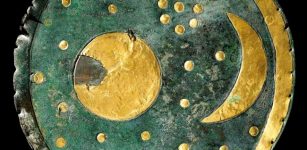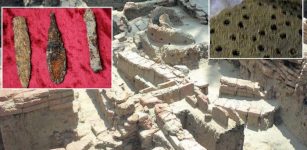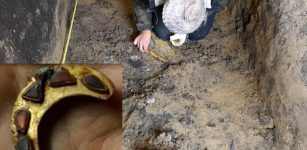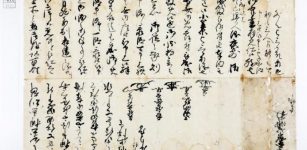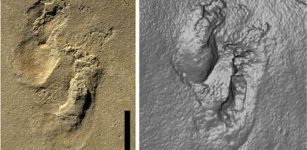Beautiful 2,300-Year-Old Gold Ring Found In The City Of David
Jan Bartek - AncientPages.com - The recent discovery of a 2,300-year-old gold ring set with a precious stone in the City of David, Jerusalem, Israel, is a significant archaeological find. The ring's small diameter suggests that it belonged to a child, either a girl or a boy, who lived in Jerusalem during the Hellenistic period. Experts have described the find as "unusual and deeply moving," as such discoveries are not made daily.
Credit: Israel Antiquities Authority
The gold ring, dating back to the early Hellenistic period, was unearthed during a joint excavation by the Israel Antiquities Authority and Tel Aviv University in the City of David, part of the Jerusalem Walls National Park. The Elad Foundation supported the excavation. The ring, made of gold and set with a red precious stone, likely a garnet, is remarkably well-preserved due to the refined nature of gold, which has prevented it from rusting or weathering over the past 2,300 years.
“I was sifting earth through the screen and suddenly saw something glitter. I immediately yelled, ‘I found a ring, I found a ring!’ Within seconds, everyone gathered around me, and there was great excitement. This is an emotionally moving find, not the kind you find every day. In truth, I always wanted to find gold jewelry, and I am very happy this dream came true - literally a week before I went on maternity leave,” says Tehiya Gangate, a City of David excavation team member who founf the ring.
Dr. Yiftah Shalev and Riki Zalut Har-tov, Israel Antiquities Authority Excavation Directors, said, “The ring is very small. It would fit a woman’s pinky or a young girl or boy’s finger.
Professor Yuval Gadot of Tel Aviv University and excavator Efrat Bocher point out this archaeological find sheds new light on the nature and status of Jerusalem's inhabitants during the Early Hellenistic Period. This ring, along with other ornaments like the horned animal earring and decorated gold bead found in the City of David excavations, suggests a thriving economy and elite status for the city then.
Contrary to previous assumptions that Jerusalem was a small town with limited resources, the aggregate of revealed structures now constitutes an entire neighborhood, indicating the city extended westward from the hilltop. The buildings' character, gold finds, and other discoveries attest to a healthy economy and openness to the widespread Hellenistic style and influences prevalent in the eastern Mediterranean Basin.
Credit: Israel Antiquities Authority
Gold jewelry was well-known in the Hellenistic world from Alexander the Great's reign. His conquests facilitated the spread and transportation of luxury goods and products. Often, jewelry decorations were drawn from mythological figures or significant symbolic events, reflecting the cultural influences of the time.
See also: More Archaeology News
This exceptional find will be exhibited to the public during the "Jerusalem Mysteries" conference, which the Israel Antiquities Authority will host on Jerusalem Day at the Jay and Jeanie Schottenstein National Campus for the Archaeology of Israel.
Written by Jan Bartek - AncientPages.com Staff Writer




